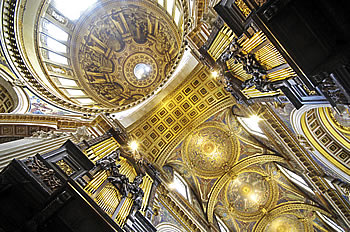Simon Johnson – St Paul’s Cathedral Virtuosi series
June 3rd 2010

For the second recital in the Virtuosi series at St Paul’s on June 3, the Cathedral’s own Organist Simon Johnson offered a disparate but cohesive programme; and despite the stylistic variety, three of the four pieces were, remarkably, written within a period of just 33 years. Far from being defeated by this, Johnson succeeded in demonstrating the great contrast of moods and colours of the instrument he knows so well, and moreover to show that he was always in control of the music as a whole and the effects at each particular moment.
Bach’s C minor Prelude and Fugue BWV 546 began the recital, the prelude played majestically with the pedal line ominously coming through, no doubt assisted by the acoustics of the Dome; the fugue in contrast was taken more steadily and intimately, but still with logic and motion. On paper, following the forward drive and development of the fugue with Messiaen’s Le banquet céleste would seem to be such a complete contrast as to be perverse, being the first of Messiaen’s rapt contemplations of eternity in which he seeks to bring about an effect of time in suspension. However, having established a certain calm and stability with the fugue, perhaps such a mystical meditation could be the only emotionally satisfying outcome of Bach’s impeccably worked-out logic. My only qualm with the performance of the Messiaen is that it wasn’t actually slow enough – with a tempo of quaver = 52, it must be absolutely still, allowing the exotic harmonies to unfold in a non-linear way, as though they were a haze of perfumes wafting around the Dome.
Another apparent contrast followed with the sturdy, upright opening of Elgar’s G major Sonata op 28. In the extensive recital notes (one of the many good things about the whole series) Johnson conceived of this work as essentially orchestral, and interpreted it accordingly with different registrations to bring out different sonorities. For instance there was a delicate luminosity for the second subject of the first movement, the second movement featured a finely wrought line in the upper register supported above an appropriately sustained cello-like timbre, while in the Andante third movement Johnson sustained a rich and intense tone that might almost have been the same lush tone of the whole orchestra in one of the slow movements from either of the Symphonies. Throughout, Johnson maintained a masterly control, revealing through the differing moods and sections that the work is essentially an organic whole and can be seen as a symphony for the organ, that is also a preparation for Elgar’s real essays in the genre – the Sonata’s jaunty opening looks ahead to the opening of the Second, while the Andante has the same ‘heroic melancholy’ as the Adagio of the First.
To end, Johnson played an arrangement of the Berceuse and Final from Stravinsky’s Firebird – the former was starkly forlorn while the noble melody of the Final emerged as if from afar, blazing into full glory, with the last held chord making thrilling use of the swell. For an encore Johnson returned to the intimate side of Elgar with the slow movement of the Serenade for Strings, bringing out an effortless tenderness. A very memorable and satisfying recital.
Curtis Rogers
